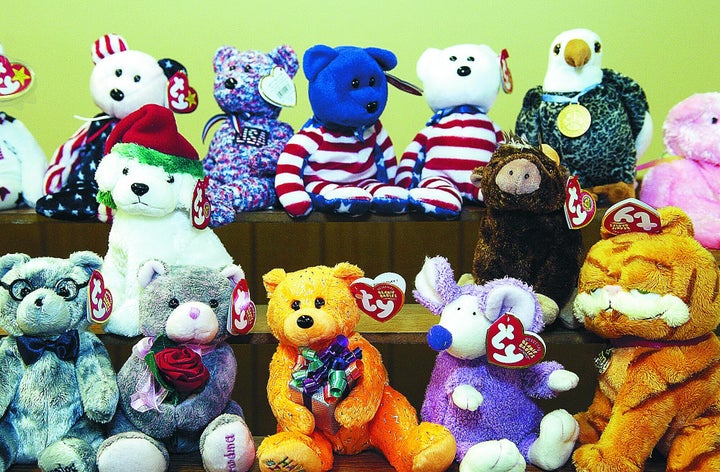
Is it a cup or a cult?
Earlier this week, Stanley, the company behind the TikTok-famous vacuum-insulated tumblers, released its limited edition Valentine’s Day collaboration cups with Starbucks, to unbelievable fanfare.
The cups, sold exclusively at Target stores, had some people camping outside their local stores to secure the goods. Videos posted on TikTok show parched fans racing through the aisles of Target to get to the 40-ounce water bottles.
A video on TMZ shows a man desperately jumping over the counter at a Target’s Starbucks to steal a box of the tumblers, which run for $45 apiece. (Water is essential, people, but a Stanley cup is not!)

The new Stanley cups, which come in Cosmo Pink and Target Red, are already up on resale sites like eBay and listed at prices up to $300 ― not surprising given the fact that a rep for Starbucks confirmed that the cup will not be restocked.
Confused by the hoopla over a water bottle? Understandable. Below, we unpack why seemingly everyone and their mother are trying to get their hands on the cup.
It has a solid reputation on social media.
The hype over the Stanley Cup among millennial and Gen Z women (and more recently, Gen Alpha preteens) began on social media, specifically on TikTok. There, users sing the praises of all things Stanley and show off the myriad accessories they’ve bought to upgrade their tumblers:
The fandom around water bottles coincides with the “WaterTok” trend, in which people share how they turn their H2O into “spa water” or “birthday cake water” with different powders and ingredients.
Hydro Flask, Yeti and cooler brands like Frank Green have their well-hydrated fans, too, but they’re nothing compared to the Stanley evangelists.
“Let’s talk about the Stanley cup and what makes it so life changing,” one TikTokker intoned in her video. “I get it, you probably don’t want another cup but you need this cup.”
As of now, “Stanley Cup” — the tumbler, not the trophy awarded to the winner of the National Hockey League championship — has over 52.7 million views on TikTok. That’s a pretty impressive youth following for a brand that’s over 100 years old.
“When I was 11, I asked for dolls. Today’s 11-year-olds asked for Stanley tumblers,” Casey Lewis, a youth consumer trends analyst who writes the newsletter After School, told Business Insider recently. “Seeing Gen Alpha kids sobbing over water bottles is pretty surprising.”
Ashlee LeSueur, a co-founder of the Buy Guide, an online shopping blog and Instagram account, was an early adopter of the Stanley Quencher back in 2017.
“Of all the insulated cups... this is the one. Just trust,” LeSueur and her team wrote in 2017, raving about its ability to keep beverages cold, its straw, its handle and its ability to be tossed in the dishwasher.
A viral story in November about how a Stanley tumbler was the only item that survived a car fire (with ice still inside, no less) cemented Stanley’s “unbreakable” reputation.
Given the brand’s image ― and the love for all things pink post-“Barbie” movie ― LeSuer isn’t surprised the new pink-hued edition is selling out.
“The consumers have made it abundantly clear that colour is king,” she told HuffPost. “And the craze around the Stanley Quencher isn’t new! Even in 2021 Stanley’s website had a 30,000-person waitlist for restock notifications on the cup.”
It’s a perfect example of the scarcity model in motion.
The Furby-esque frenzy around the Stanley cup is clearly the scarcity model at work: The idea that something is rare or limited edition works wonders on buyers.
The fact that the Stanley cup presents affordable scarcity tips those “I’ve gotta have it” feelings over the edge, said Katie Thomas, the lead of the Consumer Institute at Kearney, a global management consulting firm.
“While the scarcity model is often associated with luxury, that’s exactly the reason it’s also appealing in the mainstream ― it allows consumers to feel like they are getting something special that not everyone has, without being priced out,” she said.
It taps into the emotions of consumers, Thomas said, “from the excitement leading up to the release, to the personal victory and gratification if and when the product is acquired.”
The need to buy one speaks to our larger need to belong.
Hannah Shamji is a consumer insights researcher who helps marketers and founders make smarter decisions by understanding their customers. The way she sees it, people aren’t buying a Stanley mug. They’re buying into the Stanley club.
“You don’t stampede in Target for a tumbler,” she said. “What [people] are buying is [a sense of] belonging. People want to be in the know or fit in.”
It’s a status move, Shamji said, and that’s not a bad thing: “Status is a really powerful driver of purchase behaviour, because it tugs on a very fundamental human need: to belong.”
It’s why so many people are commenting or posting about the Stanley cup online, too, she said. They want to be a part of the conversation and join the hype.
“Even though fans can sing its praises, people are not buying a Stanley cup because of its features and functionality,” she said. That’s not why the cup sold out in minutes, Shamji explained, or why people buy multiple colours when you really only necessitate one water bottle.
“I saw one woman on TikTok with a cup in every colour: The full rainbow of Stanleys,” she said. “She’s not buying on need or because the Stanley is objectively better than the Yeti. It’s not a logical or calculated purchase decision. It’s a feeling-based one.”
The cup is a social currency, Shamji said, a flex, just like a large collection of Beanie Babies (of all things) were years ago.

Have we reached peak Stanley cup?
Will the excitement over Stanley tumblers last? Lewis, the youth consumer trends analyst, told Business Insider she thinks there’s nowhere to go but down from here for Stanley.
“When young kids and tweens adopt a trend or product, teens and older Gen Z distance themselves,” she said.
Affordable products that also signal social status from being cool or “in the know” often take off in the marketplace, but therein lies the downside: No one wants what everyone has.
“The risk for a brand like Stanley is that it might become ubiquitous and is therefore no longer a symbol for one-upping in one’s social network,” said Steve Westberg, an associate psychology professor at the University of Southern California with expertise in consumer psychology.
“There’s also the inherent factor that not everyone needs a cup like this and those who do probably don’t need more than one, so the total market volume has a limit,” he added.
Westberg told HuffPost he thinks the water bottles will see a sales decline when the social factor no longer drives sales, but that they’ll still merit shelf space “just based on just being a darn good cup.”
From Furby to Tickle Me Elmo to Beanie Babies, there will always be products that people gravitate toward and collect. It’s not entirely explainable why, said Thomas: Sometimes it’s just the scarcity in and of itself and the visibility of the product.
“That said, these ‘trendy’ products also have to perform on their intended function,” she said. “In the case of Stanley, the quality of the product delivers, as proven by the viral car fire video where the cup was not only intact but still had ice in it.”